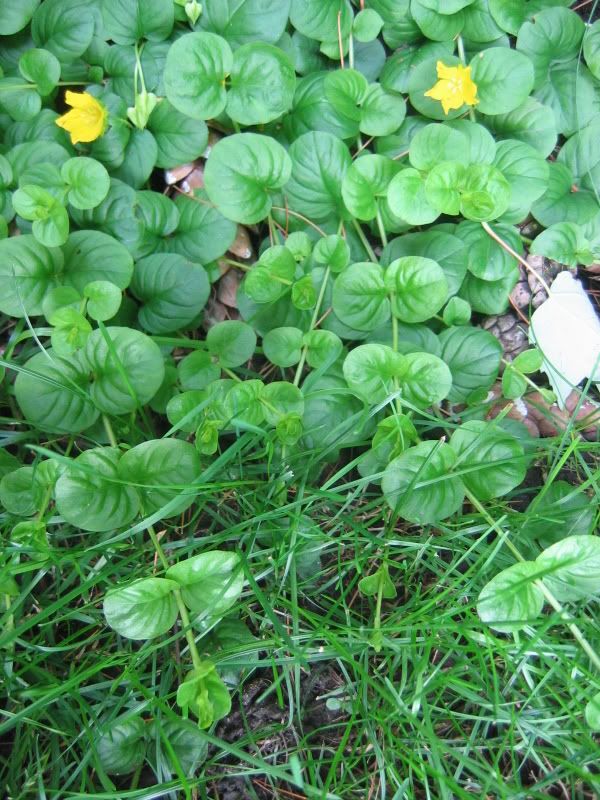They warned me... updated
...but did I listen?? Noooooooo! Creeping Jenny will invade the lawn, said they. Whatever, thought I.
Creeping Jenny will invade the lawn, said they. Whatever, thought I.
In previous years I had no problem, as my former back yard had no grass, and I'd just give it a haircut now and again when it spread too far on the patio. Last year it was not a problem, as I had it in a dry little corner that dampened its enthusiasm. (Lovely little gardening paradox there, but I'll let you chew on it without any further help.) Then I moved it out from under the overhang and the games began.
OK, so this is an overdramatization. I watched it spread into the lawn for at least a week or two before I cared enough to do something about it. At that point some of the runners were easily extending a good 12 inches into the lawn. Feeling a little sheepish at my inaction, I picked up a standard pair of household scissors, cut along the dotted line and easily pulled up all the little runners that were starting to root in the lawn. Reports of its invasiveness are greatly exaggerated.
Mind you, if I were gardening on an acre or two and had fifteen large beds to maintain, I would probably have a very different attitude. Then I would definitely avoid planting creeping Jenny near grass. But it would still be lovely along a retaining wall or tucked into containers.
And this is one of the nice things about Lysimachia nummularia aka moneywort aka creeping Jenny. If you grow a patch or two in your garden, it is an easy matter to take a handful or two and plant it in containers as a trailing plant. In mid-summer, you'll get lovely little yellow flowers as a bonus. I didn't do too much container-stuffing this year, as my patch was very small, but next year I'll likely do quite a bit more. For now, I've underplanted my potted royal fern with creeping Jenny and Johnny-jump-ups. I'll post a picture later in the season when more of it is dripping over the sides.
My original plant came from cuttings taken in the woods, as this is a native species. It does best in partial shade; too much sun tends to dry it out and not enough sun makes for fewer flowers. Mine doesn't get quite enough, but I can live with fewer flowers. The cultivar normally sold in garden centres, L. nummularia 'Aurea', has golden leaves, requires more sun because it has less chlorophyll, and is less vigorous in its growth. It would probably be a little easier to control.
UpdateI erred in calling Lysimachia nummularia a native plant. Please read Xris's comment for correction and further info.
Technorati tag: Creeping Jenny


2 comments:
Lysimachia nummularia is native to Europe, and introduced to Nroth America. it may be naturalized, but it's not native. Removing it from the wild is encouraged! It can be invasive in the right/wrong setting. For example, in Massachusetts, it's illegal to import or propagate this plant.
Check out USDA PLANTS, IPANE, and Wikipedia for more info.
Janet, janet. I've posted several warnings about this plant. I, too, was drawn in by it, figuring I could contain it. It almost became like kudzu in one of my perennial beds. (Okay, now I exaggerate a little...)
I cringe when I see this for sale, knowing that someone is going to regret their purchse.
Post a Comment